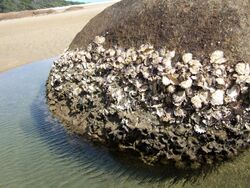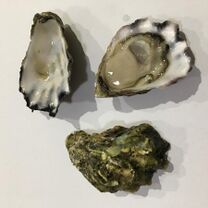Biology:Saccostrea glomerata
| Saccostrea glomerata | |
|---|---|

| |
| Oysters on a rock at low tide, Wingan Inlet | |
| Scientific classification | |
| Domain: | Eukaryota |
| Kingdom: | Animalia |
| Phylum: | Mollusca |
| Class: | Bivalvia |
| Order: | Ostreida |
| Family: | Ostreidae |
| Genus: | Saccostrea |
| Species: | S. glomerata
|
| Binomial name | |
| Saccostrea glomerata (Gould, 1850)
| |
| Synonyms | |
|
Saccostrea commercialis | |
Saccostrea glomerata is an oyster species belonging to the family Ostreidae.[5]
It is endemic to Australia and New Zealand. In Australia, it is known as the Sydney rock oyster and is commercially farmed. In New Zealand, where the species is not farmed, it is known as the New Zealand rock oyster or Auckland oyster. The species is closely related to Saccostrea cucullata, the hooded oyster, which is common on Indo-Pacific rocky shores.[6]
Sydney rock oysters are capable of tolerating a wide range of salinities. They are usually found in the intertidal zone to 3 m (9.8 ft) below the low-water mark.
Taxonomy
The Sydney rock oyster and New Zealand rock oyster have previously been classified as two separate species: Saccostrea commercialis and S. glomerata, respectively.[7] They have also been grouped with the hooded oyster into a single species, S. cucullata.[lower-alpha 1][lower-alpha 2]
When proposing the name Ostrea commercialis in 1933, Iredale & Roughley noted that the New South Wales oyster had been variously referred to species O. cucullata Born (Ascension Island), O. mordax Gould (Fiji), O. glomerata Gould (New Zealand), O. circumsuta Gould (Fiji); and even to O. trigonata Sowerby and O. mytiloides Lamarck.[3]
Distribution
In Australia it is found in bays, inlets and sheltered estuaries from Wingan Inlet in eastern Victoria, along the east coast of New South Wales, and north to Hervey Bay, Queensland, around northern Australia and south along the west coast to Shark Bay in Western Australia. The spat for these oysters travels down the east coast of Australia on the East Australia Current. Also, a small population exists on the islands in the Furneaux archipelago in Bass Strait, and in Albany on the south west coast of Western Australia, where they are farmed.
Breeding
Sydney rock oysters are "broadcast spawners", that is, eggs and sperm are released into open water where fertilisation occurs. Within hours of fertilisation, the eggs develop into free-swimming planktonic larvae. The larvae swim in estuarine and coastal waters for up to three weeks, during which they develop transparent shells and retractable feet. The larvae then settle on clean substrates using their feet to find suitable sites. The larval foot is resorbed once the larva is attached. The shell darkens and the small animal takes on the appearance of an adult oyster.
Growth rates vary with local conditions, but they generally reach 50 g (1.8 oz) in three years. Sydney rock oysters may change sex during life. Many start out as males and later change to females. About 60% of prime eating oysters are female. Selective breeding has reduced the time to market size from three to two years.[9] Great success in selection for disease resistance to two protozoan diseases of oysters, namely, QX disease Marteilia sydneyi and winter mortality Bonamia roughleyi, has been achieved.
Oysters are filter feeders, straining planktonic algae from the water. Birds, fish, stingrays, mud crabs, and starfish all eat Sydney rock oysters, with the Australian pied oystercatcher (Haematopus longirostris) being particularly fond of them.[citation needed]
Commercial industry
A substantial commercial oyster farming industry is found in New South Wales and southern Queensland, with a small, emerging industry in Albany, Western Australia. The industry produces a gourmet product and provides employment in isolated coastal communities. In Australia, oysters in peak flesh condition (i.e. spawning condition) are preferred for the half-shell trade.
Consumption
Sydney rock oysters are best consumed when freshly shucked, but do have a good shelf life when kept whole, of up to 14 days providing they are kept at the correct temperature and handled safely.
Notes
- ↑ For example, Harry's 1985 taxonomy, which was based on soft-tissue anatomy as well as shell morphology, only recognised two Saccostrea species: S. cucullata and S. palmula.
- ↑ In Born's original 1778 description, the name was published misspelled with two 'c's as S. cuccullata. Born later (1789) used S. cucullata, feminine of Latin cucullatus, 'hooded'.[8] Technically the former name has precedence, but the latter has been in wide use for over two centuries.
References
- ↑ "Taxon details: Saccostrea glomerata". World Register of Marine Species (WoRMS)
- ↑ Gould, A. A. (1850). "Descriptions of new species of shells from the United States Exploring Expedition". Proceedings of the Boston Society of Natural History 3: 346. https://www.biodiversitylibrary.org/page/8870453#page/354. The type description is from a New Zealand specimen.
- ↑ 3.0 3.1 Iredale, Tom; Roughley, T. C. (1933). "The scientific name of the commercial oyster of New South Wales". Proceedings of the Linnean Society of New South Wales 58 (2): 278. https://www.biodiversitylibrary.org/page/34948300#page/332/mode/1up.
- ↑ "Taxon details: Saccostrea culcullata". World Register of Marine Species (WoRMS)
- ↑ MolluscaBase eds. (2022). MolluscaBase. Saccostrea Dollfus & Dautzenberg, 1920. Accessed through: World Register of Marine Species at: https://www.marinespecies.org/aphia.php?p=taxdetails&id=138300 on 2022-04-27
- ↑ Lindenmayer, David; Burgman, Mark (2005). Practical Conservation Biology. CSIRO Publishing. ISBN 0-643-09089-4.
- ↑ Anderson, Timothy J.; Adlard, Robert D. (1994). "Nucleotide sequence of a rDNA internal transcribed spacer supports synonymy of Saccostrea commercialis and S. glomerata". Journal of Molluscan Studies 60 (2): 196–197. doi:10.1093/mollus/60.2.196. https://academic.oup.com/mollus/article-abstract/60/2/196/1004505. (paywall)
- ↑ Gofas, Serge (2018). WoRMS note.
- ↑ selective breeding for disease resistance and fast growth sydney rock oysters.
External links
- CIESM page on oyster species in the Mediterranean
- "Sydney rock oysters". Dictionary of Sydney. 2008. http://dictionaryofsydney.org/entry/sydney_rock_oysters. [CC-By-SA]
- https://www.dpi.nsw.gov.au/content/research/areas/aquaculture/outputs/2008/nell Retrieved 7 April 2022
Wikidata ☰ {{{from}}} entry
 |


